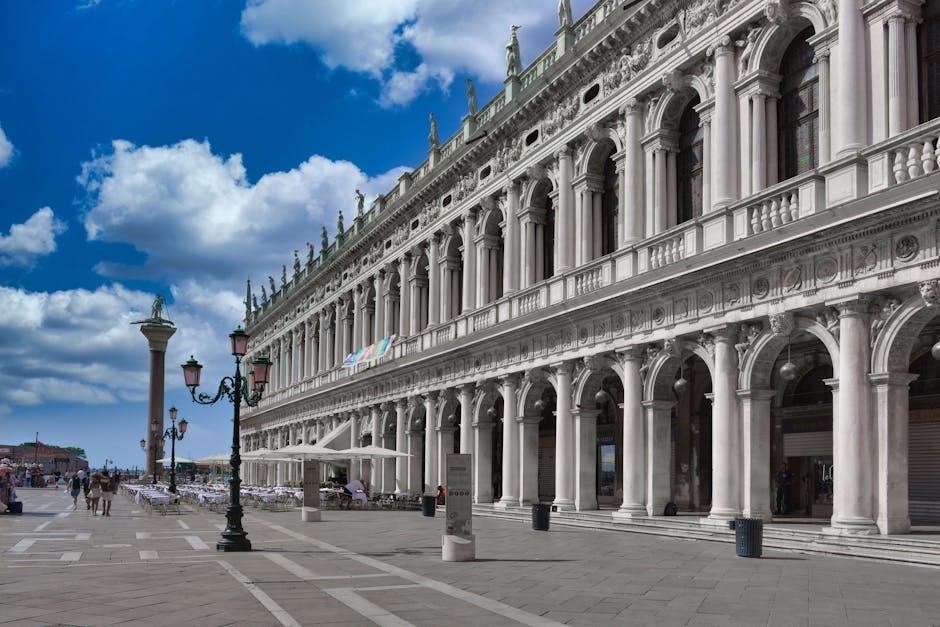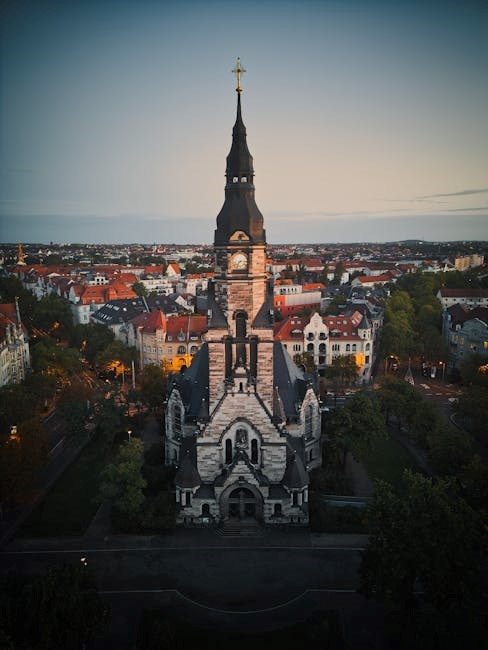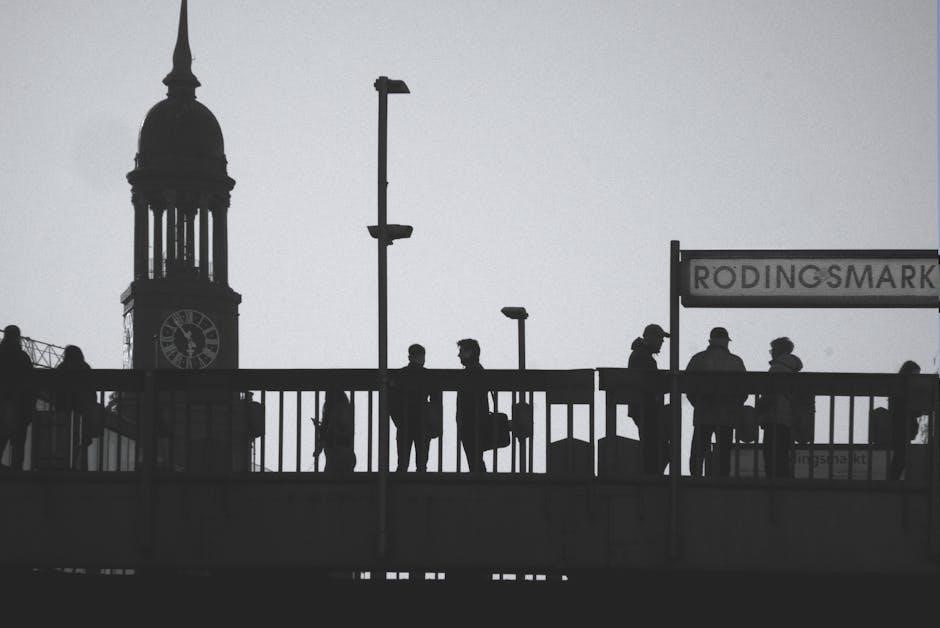Guido Reni’s St. Michael is a captivating Baroque masterpiece depicting the archangel’s triumph over Satan. Painted in the 17th century, it embodies Reni’s artistic brilliance and emotional depth, blending vibrant colors and dynamic composition to illustrate the eternal struggle between light and darkness. This iconic work not only showcases Reni’s technical prowess but also reflects his deep religious devotion, making it a cornerstone of Christian art and a timeless symbol of victory and redemption.
Overview of the Painting
Guido Reni’s St. Michael is a masterful depiction of the archangel’s victory over Satan, rendered in vibrant oil on canvas. The painting captures the dramatic moment of the celestial battle, with St. Michael poised in mid-air, his sword raised triumphantly. Satan, depicted as a fallen figure, lies defeated at the archangel’s feet. Reni’s use of dynamic poses and expressive facial expressions intensifies the emotional impact of the scene. The composition is balanced yet energetic, with flowing drapery and a striking contrast of light and dark. The vivid color palette, characterized by warm tones and radiant light, underscores the divine nature of the subject. The painting’s intricate details and harmonious proportions reflect Reni’s technical skill and artistic vision, making it a quintessential example of Baroque art. The work is both a celebration of divine triumph and a profound exploration of the struggle between good and evil.
Historical Context of the Artwork
Guido Reni’s St. Michael was painted in the early 17th century, a period marked by the rise of the Baroque style and the Catholic Church’s efforts to counter the Protestant Reformation. Commissioned by the Capuchin friars, the painting reflects the religious fervor of the time, emphasizing themes of divine triumph and moral renewal. Reni, a leading artist in Bologna, was influenced by the Carracci family’s classical ideals, which he infused with dramatic intensity. The work aligns with the Counter-Reformation’s goals of reinforcing Catholic dogma through vivid, emotionally charged art. By depicting St. Michael’s victory over Satan, Reni created a powerful visual statement of good’s triumph over evil, resonating deeply with the spiritual and cultural climate of his era. The painting remains a testament to the artistic and religious values of early modern Europe.
Artist Background: Guido Reni
Guido Reni was a prominent Italian painter from Bologna, active in the early 17th century. Born in 1575, he emerged as a leading figure in the Carracci school, which emphasized classical ideals in art. Reni’s style, known for its grace and harmony, often featured delicate forms and a refined use of color. His work was influenced by ancient Roman art and the Renaissance master Raphael, reflecting a preference for beauty and balance over the dramatic intensity of Caravaggio. Reni’s career spanned numerous religious and mythological themes, with his depictions of saints and angels showcasing his ability to convey emotional depth. Despite personal struggles, including a gambling addiction, Reni left an indelible mark on Baroque art, inspiring later artists such as Carlo Maratta. He passed away in 1642, leaving behind a legacy of elegant and spiritually resonant works.
The Artistic Style of Guido Reni
Guido Reni’s artistic style in St. Michael blends Baroque dynamism with classical grace, featuring harmonious compositions, masterful use of light and shadow, and a refined color palette that evokes deep emotion.
Baroque Style in “St. Michael”
Guido Reni’s St. Michael exemplifies the Baroque style through its dramatic lighting, intense emotional expression, and dynamic composition. The painting captures the archangel’s triumph over Satan with vivid contrasts of light and shadow, creating a sense of movement and tension. Reni’s use of chiaroscuro heightens the dramatic effect, drawing the viewer’s eye to the central struggle. The vibrant color palette and detailed textures add depth and realism, while the theatrical poses of the figures emphasize the battle’s epic nature. The Baroque emphasis on emotional intensity is evident in the expressions of both St. Michael and Satan, conveying the moral and spiritual stakes of their conflict. This masterpiece showcases Reni’s ability to blend dramatic narratives with classical elegance, making it a quintessential Baroque work of art.
Use of Light and Shadow
Guido Reni’s St. Michael masterfully employs light and shadow to create a dramatic and emotionally charged atmosphere. The painting showcases the Baroque technique of chiaroscuro, where strong contrasts between light and dark draw the viewer’s eye to the central figures. St. Michael, depicted in radiant light, symbolizes divine purity and strength, while the dark, shadowy figure of Satan embodies evil and defeat. The interplay of light and shadow heightens the tension between good and evil, creating a sense of movement and energy. Reni’s use of light not only highlights the archangel’s celestial nature but also emphasizes the moral and spiritual themes of the artwork. This sophisticated manipulation of illumination and darkness underscores the painting’s dramatic narrative, making it a powerful visual representation of the eternal struggle between light and darkness.
Color Palette and Composition
Guido Reni’s St. Michael features a vibrant and harmonious color palette that enhances the painting’s emotional and thematic depth. The artist’s use of warm, golden hues for St. Michael contrasts sharply with the darker, cooler tones of Satan, symbolizing the conflict between light and darkness. The composition is dynamically arranged, with St. Michael poised in a powerful stance, his sword raised in triumph, while Satan is depicted in a twisted, defeated pose. Reni’s masterful use of color and composition creates a sense of movement and energy, drawing the viewer’s eye through the painting. The vibrant colors and balanced arrangement emphasize the struggle between good and evil, while also highlighting the archangel’s divine authority and grace. This harmonious blend of color and structure underscores the painting’s dramatic and spiritual themes, making it a quintessential Baroque masterpiece.

Themes and Symbolism in the Painting
Guido Reni’s St. Michael explores themes of divine justice, victory, and redemption. The painting symbolizes the triumph of good over evil, with St. Michael embodying light and righteousness, while Satan represents darkness and sin. The archangel’s sword and assertive stance underscore his role as a protector and defender of faith. The vivid contrast between light and dark reinforces the spiritual struggle, while the composition evokes a sense of hope and divine intervention. These themes resonate deeply within Christian iconography, making the painting a powerful visual narrative of moral and spiritual conflict. The artwork’s emotional and symbolic depth continues to inspire admiration and reflection.
Depiction of Good vs. Evil
Guido Reni’s St. Michael vividly captures the eternal conflict between good and evil. The archangel Michael, depicted in radiant light, embodies divine virtue and strength, while Satan, shrouded in darkness, symbolizes sin and chaos. Michael’s upright posture, gleaming armor, and assertive gaze convey righteousness and authority, contrasting with Satan’s twisted, serpent-like form and agonized expression. The painting’s use of color and composition amplifies this duality, with light cascading over Michael’s figure and darkness enveloping Satan. This visual dichotomy underscores the moral struggle between purity and corruption. Reni’s masterful portrayal not only reflects biblical narratives but also evokes a profound emotional response, inviting viewers to contemplate the universal theme of good triumphing over evil. The artwork’s dramatic tension and symbolic richness have made it a landmark in Christian art, resonating with its spiritual and cultural significance.
Archangel Michael as a Symbol of Victory
Archangel Michael, as depicted in Guido Reni’s painting, serves as a powerful symbol of divine triumph and victory. His authoritative stance, adorned in gleaming armor and wielding a spear, embodies the celestial warrior’s role in defeating evil. The painting captures the moment of Michael’s victory over Satan, with the archangel’s serene yet resolute expression signifying unwavering divine justice. This representation aligns with Christian theology, where Michael is often revered as a protector and defender of faith. Reni’s portrayal emphasizes Michael’s dual role as both a warrior and a guardian, reinforcing his status as a timeless symbol of victory over darkness and sin. The artwork not only celebrates Michael’s triumph but also inspires contemplation of moral courage and the eternal struggle between light and darkness.
Representation of Light Over Darkness
Guido Reni’s “St. Michael” masterfully represents the triumph of light over darkness, a central theme in Christian art. The painting vividly contrasts the radiant, heavenly figure of St. Michael with the dark, defeated form of Satan. Reni’s use of chiaroscuro creates a dramatic interplay of light and shadow, emphasizing the archangel’s divine purity and the evil’s condemnation. The vibrant colors and dynamic composition heighten the emotional impact, symbolizing the eternal struggle between good and evil. St. Michael’s luminous armor and upward gaze toward heaven underscore his connection to the divine, while Satan’s dark, twisted form embodies the chaos of darkness. This representation not only reflects the painting’s religious symbolism but also reinforces the universal theme of light prevailing over darkness, inspiring hope and moral reflection in viewers.

Key Elements of the Painting
The painting features St. Michael in a dynamic pose, wearing radiant armor, standing over a defeated Satan. The archangel’s sword and celestial demeanor emphasize divine authority, while the dark, twisted figure of Satan symbolizes evil’s defeat. The background, with its soft, ethereal light, enhances the spiritual atmosphere, drawing focus to the central battle between good and evil. Every detail, from Michael’s graceful stance to Satan’s chaotic form, contributes to the painting’s dramatic and symbolic impact, showcasing Reni’s mastery of composition and emotional expression.
The Figure of St. Michael
Guido Reni’s depiction of St. Michael is both majestic and serene, capturing the archangel’s divine authority. Clad in gleaming armor, Michael stands poised and confident, his expression steadfast and noble. His upright posture and outstretched wings convey a sense of power and grace, while his gaze reflects unwavering determination. The artist’s use of light accentuates Michael’s celestial nature, with soft, golden hues illuminating his face and armor, symbolizing purity and righteousness. The delicate folds of his garments and the intricate details of his weaponry showcase Reni’s mastery of texture and form. St. Michael’s figure is not only a visual focal point but also a profound symbol of divine victory, embodying the themes of light triumphing over darkness and good prevailing over evil. Reni’s portrayal elevates the archangel to an iconic representation of spiritual strength and hope.
Portrayal of Satan
Satan is depicted in Guido Reni’s St. Michael as a dark, fallen figure, embodying evil and chaos. Positioned at the bottom of the composition, he is shown in a state of defeat, his body twisted and contorted. Reni’s masterful use of shadow and dark tones emphasizes Satan’s malevolent nature, while his grotesque features and disheveled appearance further underscore his role as the embodiment of evil. The artist’s attention to detail in Satan’s expression and posture conveys a sense of anguish and despair, highlighting the consequences of rebellion against divine authority.
Reni’s portrayal of Satan contrasts sharply with the serene and radiant figure of St. Michael, reinforcing the painting’s central theme of good triumphing over evil. The dramatic shading and expressive details in Satan’s depiction add depth and emotional intensity to the scene, making him a compelling yet haunting figure in the narrative.
Background and Setting
In Guido Reni’s St. Michael, the background is a dramatic tableau that amplifies the painting’s emotional intensity. A dark, stormy sky with swirling clouds creates a tumultuous atmosphere, while intense shadows and highlights from divine light underscore the cosmic battle. The setting is not merely a backdrop but an active element that heightens the conflict between good and evil. Reni’s use of chiaroscuro draws the viewer’s eye to the central figures, embedding the scene with spiritual depth. The dark, undefined space contrasts sharply with the radiant light surrounding St. Michael, symbolizing the triumph of divine order over chaos. This masterful depiction of the setting enhances the painting’s narrative, transforming it into a visual representation of the eternal struggle between light and darkness.
Cultural and Religious Significance
Guido Reni’s St. Michael is a cornerstone of Christian art, symbolizing the triumph of good over evil. Its vivid imagery and emotional depth make it a powerful symbol of divine victory and moral struggle, deeply influencing religious iconography and cultural perceptions of faith.
Religious Iconography in the Painting
Guido Reni’s “St. Michael” is rich in religious iconography, depicting the archangel as a divine warrior. Michael, clad in armor and wielding a sword, embodies strength and righteousness. His scales symbolize justice, while his triumph over Satan represents the victory of good over evil. The painting’s vivid colors and dramatic lighting emphasize the spiritual battle, with Michael standing as a protector of faith. The fallen Satan, often depicted as a serpent or dark figure, signifies sin and corruption. Reni’s work draws from biblical narratives, reinforcing Michael’s role as a heavenly defender. The composition’s clarity and emotional intensity make it a powerful visual sermon, inspiring devotion and reflection. This masterpiece continues to resonate as a symbol of divine justice and hope in Christian tradition.
Cultural Impact of the Artwork
Guido Reni’s St. Michael has left an indelible mark on culture, inspiring countless adaptations and interpretations. Its vivid depiction of the archangel’s triumph has influenced artists, writers, and even popular culture. The painting’s dramatic composition and emotional depth have made it a favorite in exhibitions and religious spaces, fostering spiritual reflection and artistic admiration. Its imagery has been referenced in literature, film, and tattoos, showcasing its enduring appeal. Reni’s work continues to bridge the gap between sacred and secular art, resonating with diverse audiences. This masterpiece remains a powerful cultural icon, symbolizing courage and divine justice, ensuring its relevance across generations and mediums. Its influence is a testament to the timeless power of art to inspire and connect people worldwide.
Significance in Christian Art
Guido Reni’s St. Michael holds profound significance in Christian art, embodying the triumph of faith and divine justice. As a central figure in Christian theology, Archangel Michael represents God’s protection and victory over evil, themes vividly captured in Reni’s work. The painting has become an iconic symbol of spiritual warfare, inspiring devotion and reflection in religious communities. Its dramatic composition and emotional intensity resonate deeply with the faithful, reinforcing the Church’s teachings on morality and redemption. Reni’s masterpiece is not only a celebration of divine triumph but also a powerful visual narrative that continues to influence Christian art and devotion, solidifying its place as a cornerstone of sacred artistry. Its enduring presence in churches and religious spaces underscores its role in fostering faith and spiritual contemplation.

Technical Aspects of the Painting
Guido Reni’s St. Michael uses oil on canvas, employing chiaroscuro for dramatic lighting. Traditional materials like lapis lazuli and gold leaf enhance its vivid colors. Preservation efforts maintain its original brilliance, ensuring longevity.
Painting Techniques Used
Guido Reni employed masterful techniques in St. Michael, blending chiaroscuro and sfumato to create dramatic contrasts and soft gradations of light and shadow. His use of tenebrism emphasized the central figures, drawing focus to the divine struggle. Reni’s brushwork was precise, with delicate layers of paint to achieve depth and luminosity. He often applied glazes to enhance colors, giving the painting a rich, vivid quality. The composition’s balance and harmony reflect Reni’s classical training, while his emotional expression elevates the scene’s spiritual impact. These techniques not only highlight Reni’s technical skill but also his ability to convey profound narratives through art, making St. Michael a quintessential example of Baroque painting.
Materials and Medium
Guido Reni’s St. Michael was painted using traditional Baroque materials, primarily oil on canvas. The canvas, often made from high-quality linen, provided a durable surface for the painting. Reni utilized hand-ground pigments mixed with linseed oil, ensuring vibrant and long-lasting colors. The painting’s medium allowed for layering and blending, achieving the soft, luminous effects characteristic of his work. Natural pigments like ultramarine blue and ochre were likely used to create the vivid sky and earthly tones. The preparation of the canvas involved applying a gesso coating to create a smooth surface, with underpainting to establish composition and tonal balance. These materials and techniques not only enhanced the painting’s aesthetic appeal but also ensured its preservation for centuries. Reni’s mastery of traditional mediums contributed to the timeless quality of St. Michael, making it a testament to 17th-century artistic craftsmanship.
Preservation and Restoration
Guido Reni’s St. Michael has undergone careful preservation and restoration to maintain its artistic integrity. Over the centuries, the painting has been cleaned to remove layers of dirt and old varnish, revealing its original vibrancy. Restorers have used advanced techniques to repair cracks and flaking paint, ensuring the canvas remains stable. Environmental controls, such as consistent humidity and temperature, are employed to prevent deterioration. The restoration process has also involved re-varnishing to protect the surface and enhance the colors. These efforts have preserved the painting’s delicate details and emotional impact. The conservation of St. Michael reflects a commitment to safeguarding cultural heritage, allowing future generations to appreciate Reni’s masterpiece in its near-original state. The meticulous care given to the artwork underscores its historical and artistic significance.

Legacy of “St. Michael” by Guido Reni
Guido Reni’s St. Michael remains a celebrated Baroque masterpiece, inspiring later artists and symbolizing cultural and religious ideals. Its enduring appeal continues to captivate audiences today.
Influence on Later Artists
Guido Reni’s St. Michael had a profound influence on later artists, particularly those working in the Baroque and Neoclassical styles. Reni’s masterful use of color, composition, and emotional expression set a benchmark for depicting religious and mythological themes. His ability to balance dramatic tension with elegance inspired 18th-century artists like Anton Raphael Mengs and Jacques-Louis David, who admired his clarity and harmony. The painting’s dynamic poses and chiaroscuro techniques also influenced Romantic-era artists exploring dramatic lighting and intense emotions. Additionally, Reni’s work served as a model for religious art, encouraging artists to explore themes of spiritual triumph and moral conflict. His legacy endures as a foundational figure in the development of European art, with St. Michael remaining a timeless example of artistic excellence and emotional depth.
Popularity and Recognition
Guido Reni’s St. Michael is widely regarded as one of the most iconic works of the Baroque period, garnering immense popularity and recognition. The painting’s vivid depiction of the archangel’s triumph over Satan has made it a focal point in Christian art, celebrated for its emotional intensity and technical brilliance. Reni’s masterpiece is frequently reproduced and admired, with versions displayed in museums, churches, and private collections worldwide. Its enduring appeal lies in its universal themes of good vs. evil and light overcoming darkness. The artwork has also been referenced in literature, film, and popular culture, further cementing its status as a cultural icon. Reni’s ability to capture the essence of spiritual conflict has solidified his reputation as a master painter, ensuring St. Michael remains a timeless and captivating work of art.
Modern Interpretations and Relevance
In contemporary times, Guido Reni’s St. Michael continues to captivate audiences with its timeless themes and artistic excellence. Modern art enthusiasts appreciate the painting’s dynamic composition and emotional depth, often interpreting it as a symbol of resilience and hope. The vivid depiction of light overcoming darkness resonates universally, transcending its historical context. Digital artists and designers frequently draw inspiration from Reni’s use of color and form, incorporating elements of the painting into their work. Additionally, the artwork remains a significant cultural icon, often displayed in exhibitions and referenced in media, ensuring its relevance in today’s art world. Its enduring appeal highlights the power of classical art to inspire modern creativity and reflection.
Guido Reni’s St. Michael remains a timeless masterpiece, celebrated for its artistic brilliance and emotional depth. Its enduring legacy continues to inspire admiration and reflection in modern times.
Final Thoughts on the Painting
Guido Reni’s St. Michael is a masterpiece that transcends its historical context, offering profound insight into the universal themes of good versus evil and light overcoming darkness. The painting’s dynamic composition, characterized by the archangel’s poised strength and Satan’s dramatic defeat, creates a compelling visual narrative. Reni’s use of vibrant colors and masterful chiaroscuro enhances the emotional impact, drawing viewers into the celestial battle. The artwork not only reflects Reni’s technical skill but also his ability to convey deep spiritual and moral messages. As a result, St. Michael continues to captivate audiences, serving as both a religious icon and a celebration of artistic excellence. Its enduring appeal lies in its ability to inspire reflection on timeless human struggles and aspirations.
Guido Reni’s Contribution to Art History
Guido Reni’s St. Michael stands as a testament to his significant contribution to art history, particularly in the Baroque era. Reni’s work exemplified the balance and harmony that countered the dramatic intensity often associated with Baroque art, earning him acclaim as a master of classical ideals. His ability to fuse emotional depth with technical precision influenced countless artists, shaping the trajectory of European painting. St. Michael remains a hallmark of his oeuvre, showcasing his skill in capturing dynamic movement and light. Reni’s legacy endures through his iconic works, which continue to inspire artists and captivate audiences in museums worldwide. His contribution to art history is not only a reflection of his talent but also a celebration of the enduring power of religious and cultural themes in visual art.
